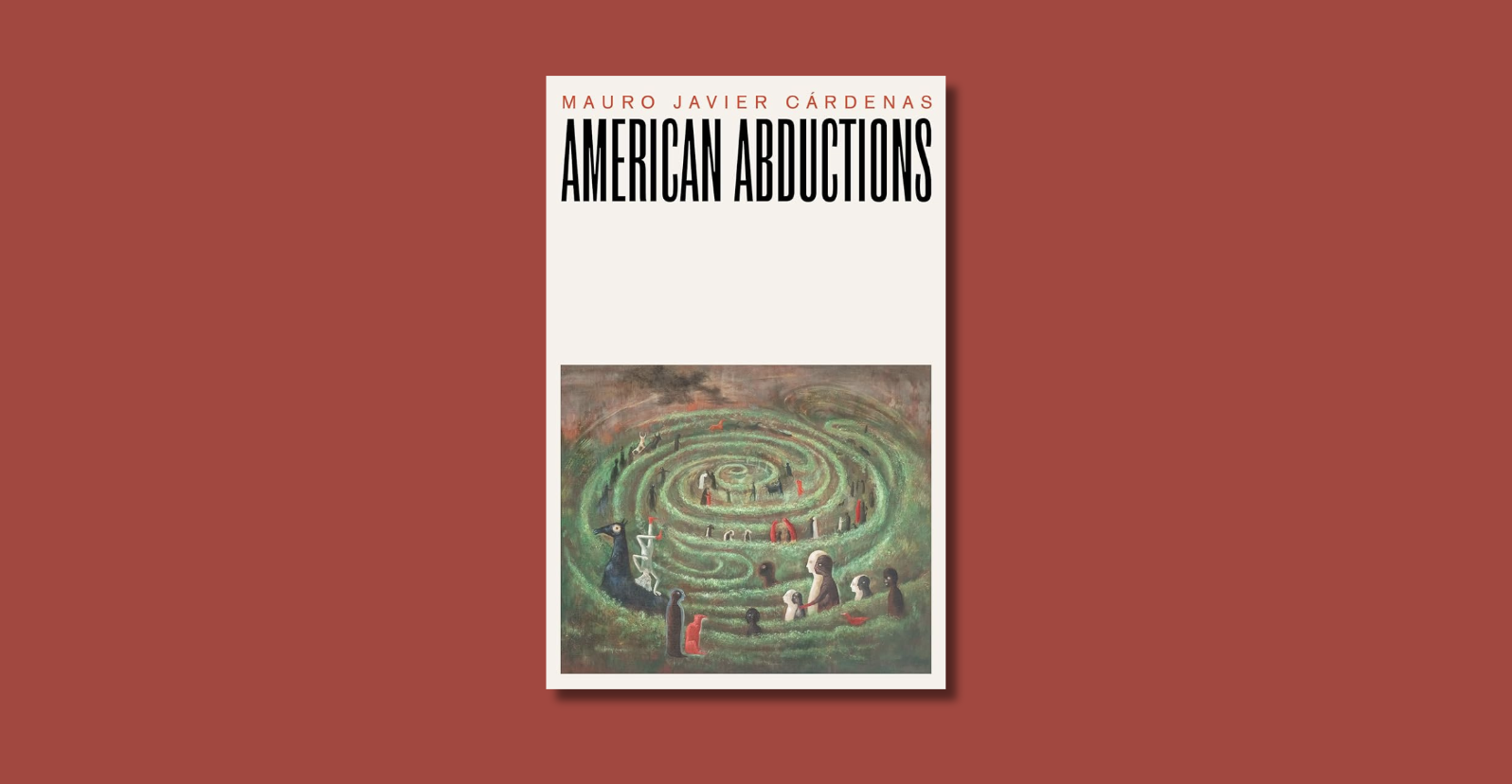With its multi-perspective, single-sentence chapters in which family mirth and strife are intertwined and the world is shared with game-playing robots, Mauro Javier Cárdenas’s latest novel American Abductions searches for, as one character puts it, “semantic rules that will connect realism to surrealism.” And while impatient readers may find its form somewhat confounding, it achieves what the author set out to do, conjuring very real political meaning from an obscure onslaught of culturally-charged, meme-laden text.
That text is peppered, for instance, with references to “the anti-immigrant tirades of the Racist in Chief,” for example, or “the American narrative machine.” “Pale Americans” asserting that “illegal is illegal” bringing about a “Purgatory of Dreamers.” The repeated refrain “Cry like an eagle.” Tongue-in-cheek, sociopolitically loaded phrases such as these emerge from relentless rushes of prose, the format of which may be obnubilate, but the implication is clear: it’s “hard not to be paranoid when the primary immigration objective of the United States was to expel us…Latin Americans.”
And as American Abductions’ enigmatic yet not-impenetrable narrative suggests, there is good reason for paranoia. After Antonio is “abducted” by ICE agents while driving his daughters to school, Ada and Eva grow up being stalked by the viral video of his arrest like Hamlet haunted by his father’s ghost. Now deported and dying in Bogotá, Antonio endeavors to chronicle the experiences of other abductees, and his growing database accumulates dire tales of family separation, madness, suicide, and murder—all of which occur under the watchful eye of a far-reaching surveillance state empowered by artificial intelligence.
While Antonio at times reads like a Leopold Bloom meandering through the steady current of unbroken thought and dialogue, with daughters Ada and Eva emerging in and out of the narrative like some two-headed Stephen Daedalus, the torrent of storytelling doesn’t spring from their vantage. While, for the most part, each chapter turns the lens on a single character, Antonio’s is a decidedly algorithmic gaze, his perspective more like that of the in-world AI surveillance system gobbling up data in its hunt for Latin Americans. This isn’t your classic stream of consciousness, but instead a stream of artificial consciousness—humanity observed rather than experienced.
We gather the story as an AI does, in an overlapping stream of images, video clips, phone calls, and the like—a deluge of data spanning everything from the mundane to the life-changing; from intimate scenes of familial love to their most agonizing moments. This vacillation between the everyday and the horrible suggests a wariness of the technological tools increasingly intruding into our lives: AI can be a toy on one hand, and a means of brutality on the other. It is the viral video that exposes the abduction, and the machine that facilitates it.
At the core of this metaphor is the great surrealist Leonora Carrington—or at least a car that talks like she wrote. Antonio, who raised his daughters on the bizarre short stories of Carrington, gives Ada a car equipped with a “Leonora Carrington Generator” that converses using lines similar to those penned by the artist—a reminder of better times before the trauma of the abduction and the separation of their family. (“My daughters love Carrington stories as much as I do,” Cárdenas told me recently. “At home her stories have become part of our private stash of references.”)
Carrington’s inclusion in the narrative speaks to the surreal nature of our association with AI. The technology helps us record our most cherished memories and can be a means of connecting with those we love—characters leverage the tech to immortalize the dead in fantastical ways, for instance—but it can also be used to weaponize our memories against us and wielded by those in power to malicious ends.
The story is populated by robots and AI-adjacent cultural touchstones that show how deeply such technology is already ingrained in our culture: Wall-E, Doraemon, South Park’s Awesome-O, Azimov and his dubiously dreaming androids, flying saucers, Star Wars, et al. Then there’s a robo-nurse called “Rob Ott” playing the game “What Came Before” with “Not Roberto Bolaño” using a narrative continuation algorithm where the latter shares the output and the former has to guess the input that elicited it.
From all of this develops a picture of a society already inundated with AI, and while many appear funny or cute, something terrible operates in parallel: the dangerously smart mechanizations of fascism and the logic of an ever-expanding target base. As Cárdenas writes:
…a linear progression with immigration enforcement focused on persecuting the undocumented first, then persecuting permanent resident aliens next, the ones who aren’t as pale as yourself, of course, but that goes without saying, then persecuting naturalized citizens like myself, which, I know, I know, is too simplistic of an assumption because once the undocumented get wind of the increase in deportations, they will stop taking their kids to school, they will stop driving to the grocery store, etc., and so the rate of capture per day is likely to decrease as deportations increase unless laws are passed that allow agents to stop anyone who doesn’t look as pale as yourself…
It is the manufacturing of the Other—the invocation of a narrowing in-group at the expense of a vague yet growing enemy portrayed as so utterly different it must be subhuman. It’s the sort of dichotomy we see in the news every day. Cárdenas continues, “Americans can’t imagine the conditions, and if they can’t imagine the conditions, they can’t imagine themselves as refugees, and if they can’t imagine themselves as refugees, they will conclude that refugees are different from them, a different species…”
In American Abductions, Cárdenas warns that we’ve already accepted authoritarianism and AI into our lives and that their impacts will become increasingly glaring and horrific. But there may still be a way out of the trap, for “boundaries between the individual human psyche and the rest of the cosmos are ultimately arbitrary and can be transcended.” In the end, the book argues, it is by transcending these boundaries that we escape the binary of us vs. them, self vs. Other. And while solutions like art and family may be inextricable from the systems and technologies that threaten their very existence, they’re also the very means of our salvation.

























































